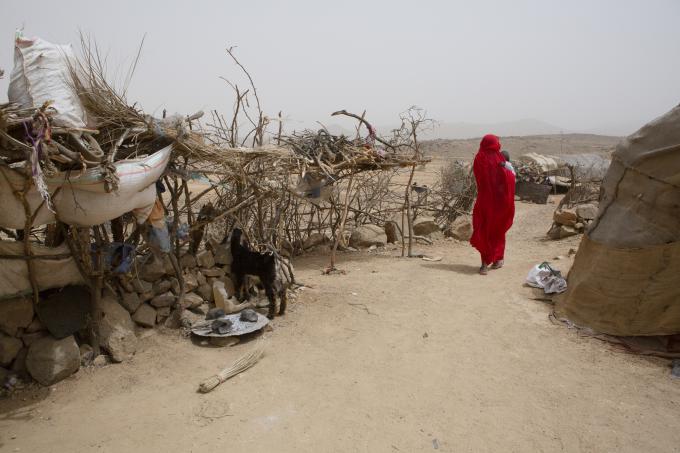رحلة راحوت الإسبوعية عبر الجبال لإنقاذ حفيدها من مرض سوء التغذية | Grandma Rahot's weekly hikes save grandson from malnutrition
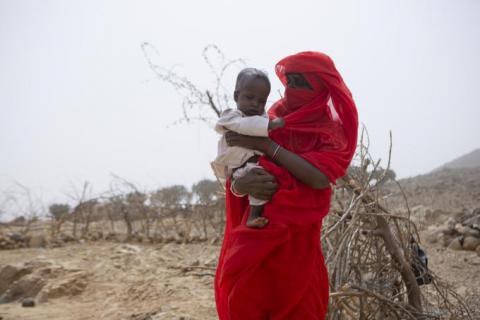
في ساعات الصباح الباكر بعد شروق الشمس مباشرة تحمل راحوت، 55 عامًا، حفيدها حسن البالغ من العمر عامًا واحدًا على ظهرها، لتبدأ رحلة لمسافة 20 كيلومترًا سيرًا على الأقدام عبر سلاسل الجبال في هلقيت، ولاية البحر الأحمر. يعاني حسن من سوء التغذية الحاد وهي مشكلة منتشرة في المنطقة التي تعاني من الفقر والجفاف.
الآن، بمساعدة جدته، يعالج في مركز صحي وغذائي، يدعمه صندوق السودان الإنساني (SHF).
تتذكر راحوت مدى قلق الأسرة عندما لاحظوا حالة حسن لأول مرة: " كان مريضًا جدًا ونحيفًا وضعيفًا، وكانت صحته تتدهور. كنا نعيش في قرية أبعد من التي نعيش فيها الآن وسمعنا عن خدمات التغذية في مركز هلقيت الصحي. قررنا الانتقال إلى قرية أقرب للمركز، لتسهيل نقله إلى هناك. ابنتي فاطمة تبقى مع أطفالها الأربعة الآخرين وأنا أحضره إلى المركز ".
كان حسن يبلغ من العمر 12 شهرًا فقط عندما تم قبوله للعلاج في المركز التي تقوم بتنفيذ نشاطاته منظمة رعاية الطفولة. في ذلك الوقت، تم قياس محيط منتصف العضد (MUAC)، وهو مقياس يستخدم لتحديد مشاكل التغذية، عند 10.2 سم، مما يدل على سوء التغذية الحاد الوخيم. في ذلك الوقت كان وزنه 5.7 كيلوجرامًا فقط وكان طوله 65.5 سم. تم تسجيله على الفور في برنامج للحصول على أطعمة مغذية وعلاجية جاهزة للاستخدام.
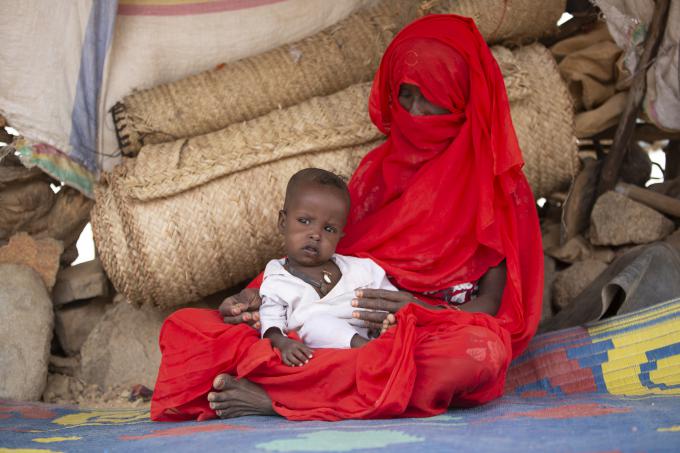
توضح الأسرة أنها لا تملك المال الكافي لشراء الطعام لأطفالها. ذهب والد حسن إلى بورتسودان، عاصمة الولاية، لكسب بعض المال. لكنه يرسل المال كل بضعة أشهر، وهذا لا يكفي لتغطية جميع احتياجات الأطفال.
في السنوات الأخيرة، شح هطول الأمطار في ولاية البحر الأحمر، مما قلل من المراعي للماشية. تُستخدم الحيوانات الآن لإنتاج الحليب المحدود فقط، وهو ما لا يكفي في كثير من الأحيان. يتكون النظام الغذائي الأساسي من الأطعمة القائمة على النشا، والتي تقدم القليل من القيمة الغذائية أو شبه المعدومة. شرحت راحوت: "نأكل الكسرة والعصيدة كل يوم. نحن لا نأكل أي شيء آخر. هناك القليل من مصادر المياه وهي بعيدة وليست نظيفة دائمًا".
بسبب الأزمة الاقتصادية وتغير المناخ، الجوع آخذ في الارتفاع في ولاية البحر الأحمر. هذا العام، وفقًا لبيانات التصنيف المتكامل لمراحل الأمن الغذائي (IPC) ، سيعاني أكثر من ثلث سكان البلاد من الأزمات ومستويات طارئة من الجوع خلال فترة العجاف (يونيو إلى سبتمبر). وهذا يعني أن العديد من العائلات ستعود إلى آليات التكيف السلبية، مثل إجبار أطفالها على الزواج المبكر، أو إرسال الأطفال إلى العمل، أو ببساطة تقليل كمية وتنوع الطعام إلى مستويات غير صحية.
ومع ذلك، فإن الجوع، وخاصة في السنوات الأولى من الطفولة، له آثار طويلة الأجل على صحة الأطفال ونموهم: بصرف النظر عن زيادة مخاطر الوفيات، يمكن أن يؤدي نقص التغذية إلى تأخر النمو والإعاقة الجسدية ويرتبط بالاضطرابات المعرفية والسلوكية عند الأطفال. خاصة عندما تحدث أثناء الطفولة المبكرة.
راحوت وعائلتها يشعرون بنوع من الراحة لأن صحة حسن قد تحسنت بشكل ملحوظ من خلال الدعم في المركز: بعد أربعة أشهر من العلاج، مع اتساق والتزام جدته، انتقل قياس محيط منتصف الذراع لحسن من الأحمر إلى الأصفر ، بقياس 12 سم، مما يشير إلى مرحلة سوء التغذية الحاد المعتدل وهو علامة رئيسية على الشفاء.
أما راحوت، فهي لا تزال مصممة على مواصلة الرحلة الأسبوعية: "لا أريد أن أفوت أيًا من مواعيده. أريد أن أراه يكبر ويكبر، وأريد أن أراه رجلاً متعلماً". وتضيف: "بالإضاقة، يبين لنا الفريق في المركز أنواع الأطعمة الصحية للأطفال وكيفية إطعامهم بطريقة متوازنة."
يزن حسن الآن حوالي 7 كجم وطوله 70 سم. على الرغم من أن صحته قد تحسنت كثيرًا، إلا أنه سيستمر في تلقي التغذية التكميلية حتى يتعافى تمامًا.
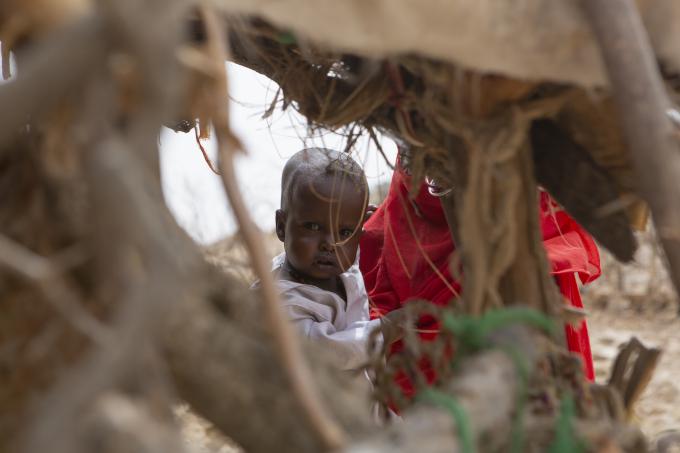
_______
(اقرأها أدناه باللغة الإنجليزية)
______
تصوير: سارة عوض (2022)
In the early morning hours, just after sunrise, Rahot, 55, lifts her one-year-old grandson onto her back, to start a 20 km journey on foot through the mountain ranges of Red Sea state. Hassan has been suffering from severe acute malnutrition, a prevalent problem in the poverty and drought-stricken region. Now, with the help of his grandmother, he is being treated in a health and nutrition centre supported by the Sudan Humanitarian Fund (SHF).
Rahot remembers how worried the family was when they first noticed the boy’s condition: “He was getting very sick, thin and frail, his health was deteriorating. We used to live in a village, even further away; through word of mouth, we heard about the nutrition services here. We decided to move to a village nearer to the facility, to make it easier to take him there. My daughter, Fatima, stays with her four other children and I bring him to the centre.”
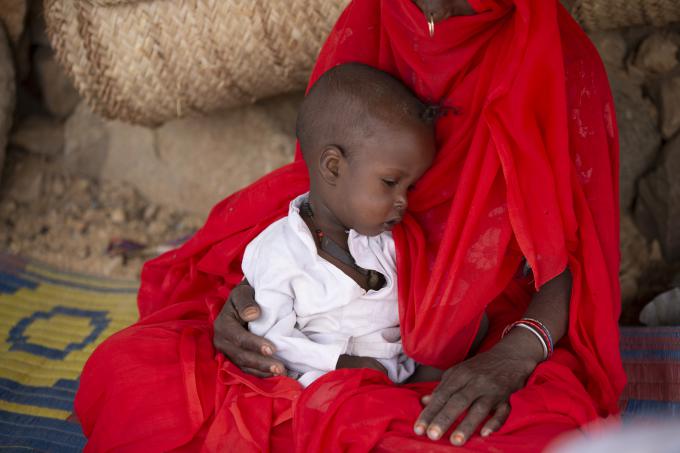
Hassan was only 12 months old when he was admitted for treatment in the facility implemented by Save the Children. At the time, his Mid-Upper Arm Circumference (MUAC), a measurement used to identify nutrition problems, measured at 10.2 cm, signifying severe acute malnutrition. At the time he weighed only 5.7 kg and was 65.5 cm tall. He was immediately enrolled in a programme to get nutritious, ready-to-use, therapeutic foods.
The family explains that they usually do not have enough money to buy food for their children. Hassan’s father went to Port Sudan, the state capital, to earn some money; but he only sends money every few months like most of the other men here in the area, which is not enough to cover all the children’s needs.
In recent years, rainfall has been scarce in the Red Sea state, reducing the grazing grounds for livestock. Animals are now only used for limited milk production, which is often not enough. The basic diet consists of plain, starch-based foods, offering little to no nutritional value. “We eat Kissra (sour flatbread), and Aseeda (local porridge) every day,” Rahot explains. “We don’t eat anything else. Also, there are few water sources and they are far away and not always clean.”
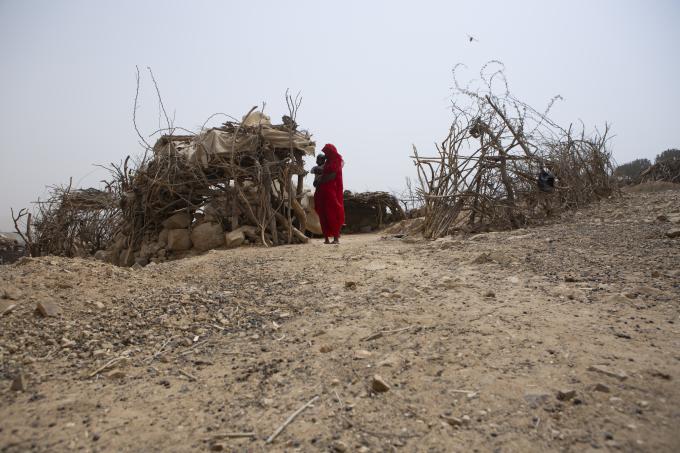
Driven by the economic crisis and climate change, hunger is on the rise in Red Sea state. This year, according to the Integrated Food Security Phase Classification (IPC) data, more than a third of the state’s population will experience crisis and emergency levels of hunger during the lean period (June to September). This means, that many families will revert to negative coping mechanisms, such as marrying their children early, sending children to work, or simply reducing the amount and variety of food to unhealthy levels.
Yet, hunger, especially in the early years of childhood, has long-term impacts on children’s health and development: apart from the increased mortality risk, undernutrition can lead to delayed growth and physical disability and is associated with cognitive and behavioural disorders in children, particularly when it occurs during early childhood.
Rahot and her family are relieved that Hassan’s health has significantly improved through the support at the centre: four months into the treatment, with the consistency and commitment of his grandmother, Hassan’s MUAC measurement went from red to yellow, measuring 12 cm, indicating the stage of moderate acute malnutrition and a major sign of recovery.
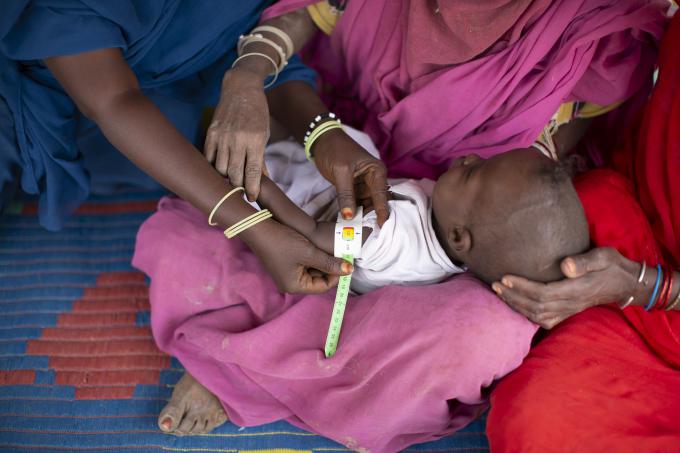
Rahot is still dedicated to continuing with the weekly roundtrip: “I don’t want to miss any of his appointments. I want to see him get bigger and older, and I want to see him become an educated man.” She says. “The team in the centre also explains to us, which foods are healthy for children and how to feed them in a balanced way.”
Hassan now weighs around 7 kg and is 70 cm tall. Although his health has improved a lot, he will continue receiving supplementary feeding, until he is fully recovered.
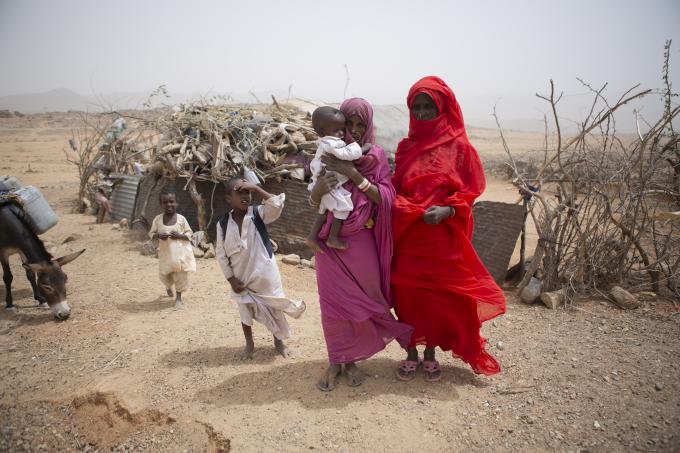
Hassan pictured with his mother, Fatima, and grandmother, Rahot
Photos by: Sara Awad (2022)
 Sudan
Sudan 